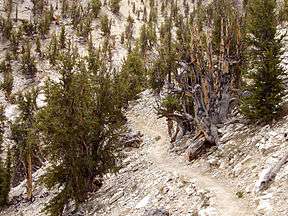Methuselah (tree)
Methuselah is a 4,851-year-old[1] Great Basin bristlecone pine (Pinus longaeva) tree growing high in the White Mountains of Inyo County in eastern California.[2][3] It is recognized as the non-clonal tree with the greatest confirmed age in the world.[4]
| Methuselah | |
|---|---|
 The Methuselah Grove | |
| Species | Great Basin bristlecone pine (Pinus longaeva) |
| Location | Ancient Bristlecone Pine Forest, in the White Mountains, Inyo County, California |
| Coordinates | 37°22′46″N 118°09′42″W |
| Date seeded | 2833 BC |
| Custodian | United States Forest Service |
Geography
Methuselah is located between 2,900 and 3,000 m (9,500 and 9,800 ft) above sea level in the "Methuselah Grove" in the Ancient Bristlecone Pine Forest within the Inyo National Forest. Its exact location is a closely guarded secret, known only to a select few.[5][6]
Status as oldest known tree
Methuselah was 4,789 years old when sampled (likely in 1957) by Edmund Schulman and Tom Harlan,[1] with an estimated germination date of 2833 BC. Since this tree ages back to this date, using tree rings, research shows precipitation patterns that dates back to 1983 BC. [7]
Other bristlecones
Another bristlecone specimen, WPN-114, nicknamed "Prometheus", was more than 4,844 years old when cut down in 1964, with an estimated germination date of 2880 BC. A dendrochronology, based on these trees and other bristlecone pine samples, extends back to about 9000 BC, albeit with a single gap of about 500 years.[8][3]
An older bristlecone pine was reportedly discovered by Tom Harlan in 2009, based on a sample core collected in 1957. According to Harlan, the tree was 5,062 years old and still living in 2010. However, neither the tree nor the sample core could be located after Harlan's death in 2013.[4]
Clonal organisms
Other, longer-lived organisms are clonal colonies, such as the 80,000-year-old quaking aspen (Populus tremuloides) colony named "Pando" in the Fish Lake National Forest in south-central Utah; the 11,700-year- old creosote bush (Larrea tridentata) colony, named "King Clone", in the Mojave Desert near the Lucerne Valley in California; and the 9,500-year-old Norway spruce (Picea abies) colony named "Old Tjikko" in Sweden.[9][10][11] Methuselah, however, is the oldest known non-clonal organism.
See also
- List of famous trees
- List of oldest trees
References
- "Pinus longaeva". Gymnosperm Database. March 15, 2007. Archived from the original on May 17, 2019. Retrieved 2015-01-04.
- "Ancient Bristlecone Pine Forest". USFS. Archived from the original on June 3, 2013. Retrieved March 11, 2013.
- "Ancient Bristlecone Pine Natural History". USFS. Archived from the original on December 27, 2013. Retrieved March 11, 2013.
- "Rocky Mountain Tree-Ring Research OldList". Archived from the original on 2 February 2013. Retrieved 6 January 2013.
- Kinkead, Gwen (June 17, 2003). "At Age 4,600-Plus, Methuselah Pine Tree Begets New Offspring". New York Times. Archived from the original on January 18, 2017. Retrieved February 19, 2017.
- Methuselah Walk. U.S. Forest Service/Eastern Sierra Interpretive Association.
- Hughes, Malcolm K., and Gary Funkhouser. “Extremes of Moisture Availability Reconstructed from Tree Rings for Recent Millennia in the Great Basin of Western North America.” SpringerLink, Springer, Berlin, Heidelberg, 1 Jan. 1998, link.springer.com/chapter/10.1007/BFb0009768.
- Hall, Carl (1998-08-23). "Staying Alive". San Francisco Chronicle. Archived from the original on 2012-02-04. Retrieved 2019-12-15.
- Vasek, Frank C. (Feb 1980). "Creosote Bush: Long-Lived Clones in the Mojave Desert". American Journal of Botany. 67 (2): 246–255. doi:10.2307/2442649. JSTOR 2442649.
- "Larrea tridentata - King Clone". High Country News. Archived from the original on 2006-05-25. Retrieved 2010-09-11.
- "World's Oldest Living clonal tree, 9550 years old, Discovered In Sweden". Science Daily. Archived from the original on 2018-03-05. Retrieved 2018-02-28.
External links
- www.fs.usda.gov — Inyo National Forest official Ancient Bristlecone Pine Forest site
- www.fs.usda.gov — Inyo National Forest: The Natural History of the Bristlecone Pines
- Hughes, Malcolm K.; Funkhouser, Gary (1998). "Extremes of moisture availability reconstructed from tree rings for recent millennia in the great basin of western north America". The Impacts of Climate Variability on Forests. Lecture Notes in Earth Sciences. 74. pp. 99–107. doi:10.1007/BFb0009768. ISBN 3-540-64681-7.